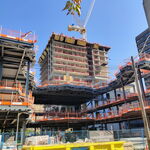Eug
Senior Member
This is from last year, but I didn't see this posted:
New High Speed Rail: Toronto Montreal corridor
New High Speed Rail: Toronto Montreal corridor
This is from last year, but I didn't see this posted:
New High Speed Rail: Toronto Montreal corridor
Hahaha! I love you Rick Mercer.
Haha...that's hilarious. The sad thing is they're even slower than in the 70s. I remember the 3h59m schedules on the Metropolis from Toronto to Montreal. They stretched those out five or six years ago, I think.
The 3:59 timetable was introduced in October 1992, and it lasted until 2005 IIRC. Even the much-vaunted Turbo couldn't beat 4:30, which is not far off of what we have now.
The three rebuilt 9-car sets entered service for CN in late 1973. CN ran the Turbos from Toronto-Montreal-Toronto with stops at Dorval, Quebec, Kingston, Ontario and Guildwood, Ontario on the Quebec City-Windsor Corridor. Original train numbers were Train 62 which left Toronto at 12:45 p.m. and arrived in Montreal at 4:44 p.m. Train 63 left Montreal at 12:45 p.m. and arrived in Toronto at 4:44 p.m. (Both were daily trains.) Train 68 left Toronto at 6:10 p.m. and arrived in Montreal at 10:14 p.m., while Train 69 left Montreal at 6:10 p.m. and arrived in Toronto at 10:14 p.m. (The evening trains did not run on Saturdays.) The trip took 3 hours and 59 minutes downtown-to-downtown on trains 62 and 63, while the evening trains were slightly slower, taking four hours and four minutes to complete the run. Turbo service was about a full hour faster than CN's previous express trains, the "Rapido".
Interesting. I didn't know that. I was sure that the Turbo matched that time, and I was also going by Wikipedia but obviously that's not always the most accurate source! Here's what I read:
Anyway, I wonder what happened. What did they do in the early 90s that got the times down, and why couldn't they sustain it?
Wait they removed track and are putting it back?? :-/
Making a case for high-speed rail
Canada remains the sole G8 country without an example of this super fast and super efficient means of transportation.




